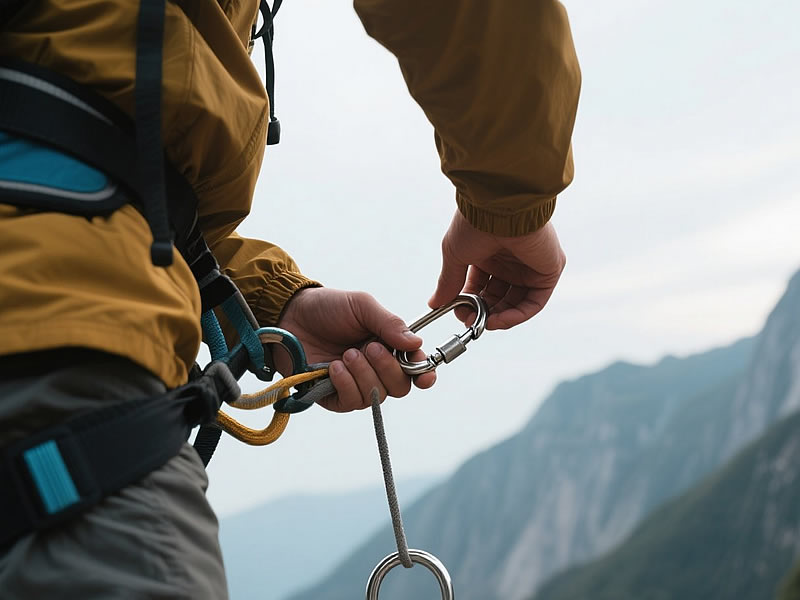Proper way to rack climbing carabiners on harness
Climbing carabiners are critical safety tools, but improper racking on your harness can lead to inefficiency, gear damage, or even accidents. This guide outlines the best practices for organizing carabiners, ensuring they’re accessible, secure, and compliant with industry standards. Whether you’re a beginner or an experienced climber, mastering these techniques will enhance your performance and safety on the wall.

1. Understanding Carabiner Types and Their Uses
Before racking, familiarize yourself with different carabiner types:
- D-shaped Carabiners: Ideal for high-load scenarios (e.g., belaying, anchor systems) due to their strength and minimal weight.
- Oval/Keylock Carabiners: Versatile for multi-purpose use, such as attaching slings or quickdraws.
- Auto-Locking Carabiners: Feature a spring-loaded gate that automatically locks, reducing human error.
- Screwgate Carabiners: Require manual tightening, offering extra security for critical connections like anchors.
- Key Insight: Always use UIAA 121 or ANSI/ASSE Z359.12-certified carabiners for safety . Avoid using non-locking carabiners for load-bearing applications.
2. Step-by-Step Racking Process
a. Organize by Function
Group carabiners based on their intended use:
- Belay/Anchor Carabiners: Locking carabiners (screwgate or auto-lock) for critical connections.
- Quickdraws: Non-locking carabiners paired with slings for clipping protection points.
- Accessory Carabiners: Smaller carabiners for attaching gear like chalk bags or tools.
b. Harness Gear Loops vs. Gear Slings
- Harness Gear Loops: Use these for frequently accessed gear (e.g., quickdraws). Clip carabiners with gates facing away from your body to prevent accidental snagging.
- Gear Slings: Ideal for carrying extra gear (e.g., cams, nuts) during multi-pitch climbs. Attach slings diagonally across your chest for balance.
c. Proper Clipping Techniques
- Gate Orientation: Ensure carabiner gates face downward and away from the direction of pull to minimize accidental opening. For example, on a quickdraw, the gate should face the 岩壁 when clipped into a bolt .
- Double-Locking for Anchors: Use two locking carabiners (e.g., screwgate + auto-lock) for anchor systems, with gates facing opposite directions to avoid cross-loading .
- Avoid Overcrowding: Leave space between carabiners to prevent entanglement. A general rule: no more than 3-4 carabiners per gear loop.
3. Common Mistakes to Avoid
a. Incorrect Gate Direction
- Risk: If a carabiner’s gate faces upward or toward the direction of pull, it may open under stress.
- Solution: Always orient gates downward and away from your body.
b. Mixing Locking and Non-Locking Carabiners
- Risk: Using non-locking carabiners for critical connections (e.g., belay loops) can lead to catastrophic failure.
- Solution: Reserve locking carabiners for anchors, belays, and rappels.
c. Overloading Gear Loops
- Risk: Overcrowded loops make gear hard to access and increase the risk of damage.
- Solution: Use gear slings for bulkier items and limit each loop to 3-4 carabiners.
4. Advanced Racking Strategies
a. Traditional Climbing (Trad) Racking
- Organize by Size: Clip cams and nuts in ascending order from smallest to largest on your harness or gear sling. This allows quick access during lead climbs .
- Color-Coding: Use colored slings or carabiners to distinguish gear types (e.g., red for cams, blue for nuts).
b. Sport Climbing Racking
- Quickdraw Placement: Attach quickdraws to your harness loops with gates facing downward. For outdoor routes, pre-clip quickdraws to reduce climbing time.
c. Multi-Pitch Racking
- Distribute Weight: Balance heavy items (e.g., cams) across both sides of your harness to avoid strain.
- Rappel Setup: Reserve two locking carabiners for rappel anchors and ensure they’re easily accessible.
5. Maintenance and Inspection
- Regular Checks: Inspect carabiners for cracks, corrosion, or gate misalignment before each use.
- Cleaning: Wipe carabiners with a dry cloth to remove dirt and avoid harsh chemicals.
- Storage: Store carabiners in a cool, dry place away from direct sunlight to prevent material degradation.
6. SEO Optimization Tips
To ensure this guide ranks well on search engines:
- Keywords: Use terms like climbing carabiner racking techniques, proper harness organization, and UIAA 121 standards.
- Structure: Break content into clear sections with H2/H3 headers (e.g., Step-by-Step Racking Process).
- Internal Links: Link to related articles (e.g., How to Choose Climbing Carabiners).
- External Links: Cite authoritative sources like UIAA or REI .
Conclusion
Properly racking climbing carabiners on your harness is essential for safety, efficiency, and performance. By organizing gear logically, avoiding common mistakes, and adhering to industry standards, you’ll minimize risks and focus on the climb. Remember: a well-racked harness is a climber’s best tool—train consistently to make these techniques second nature.






